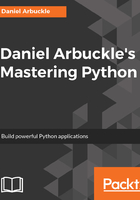
Choosing a suitable version
There are currently two common varieties of Python in use. One of them is Python version 2.7, which is the final version of the Python 2 series. The Python community has promised to maintain version 2.7 independently, making it a very stable target for development. The other common version is Python 3, which at the time of writing this book is in version 3.6.
Python 3 is where the Python community is innovating. The releases are always backward compatible with earlier version 3 releases, but new exciting features are added regularly. During the change to version 3, the language in the libraries was changed in subtle ways, as you can see in the comparison of the following two code snippets:

In the preceding screenshot, on the left-hand side is Python 2 and on the right-hand side you see an equivalent code in Python 3. They are almost the same, but have differences, such as placement of parentheses, a few keywords, and a slightly different structure than the standard library. You're free to pick whichever version or versions you want for your own projects, but for this book, we'll be using Python version 3.
Now that we have picked the version, let's install it.